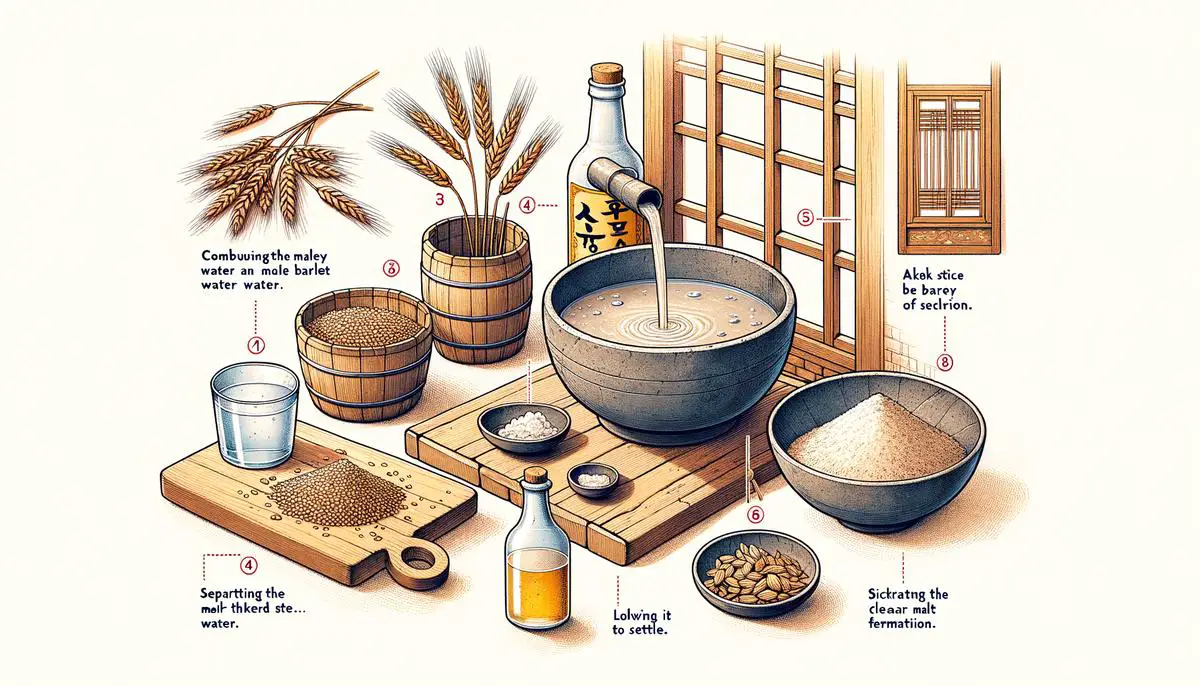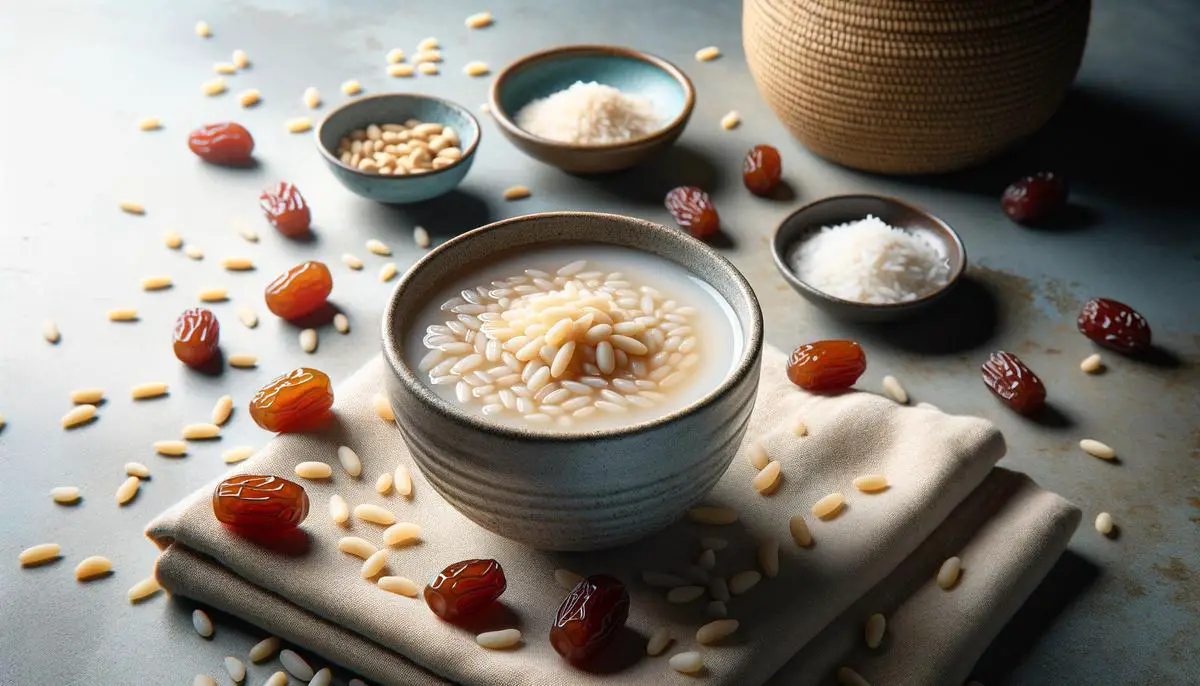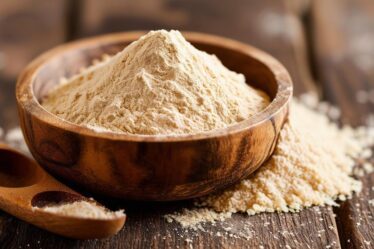
Preparing Malt Water
Preparing Malt Water for Sikhye: A Step-By-Step Guide
Creating sikhye, a traditional Korean sweet rice drink, begins with preparing malt water. This step extracts the sweetness from malted barley, which is important for sikhye's flavor. Follow this guide to make your own malt water, helping your sikhye achieve a good balance of sweetness and maltiness.
What You'll Need:
- 8 ounces of barley malt (yeotgireum-garu)
- 18 cups of cold water
- A large bowl
- A whisk or wooden spoon
- Strainer or cheesecloth
Steps to Prepare Malt Water:
- Mix Malt with Water: In a large bowl, mix the 8 ounces of barley malt powder with 14 cups of the cold water. Use a whisk or a wooden spoon to ensure the malt powder disperses within the water.
- Let It Settle: Once you've mixed the malt powder and water, let the mixture sit for 2 to 3 hours. This allows the malt powder to settle at the bottom of the bowl.
- Separate Clear Malt Water: After the settling period, carefully pour the clear water into another container. This clear liquid is your malt water. Do this gently to avoid disturbing the settled malt powder at the bottom.
- A Second Round: Don't discard the remaining malt sediment yet! Add the remaining 4 cups of cold water to the malt sediment. Stir it slightly and let this second mixture sit and settle while you begin fermenting rice in your sikhye preparation. This step helps maximize the malt flavor.
- Strain If Needed: If your first transfer of clear malt water involved some sediment, run it through a strainer or cheesecloth to remove any remaining impurities.
- Starting Your Sikhye: Now that you have your clear malt water ready, you can proceed with mixing it with cooked rice and setting your rice cooker to 'warm' to start the fermentation process. The malt water's enzymes will transform starches into sugars, giving sikhye its naturally sweet taste.1
Making good malt water requires patience and precision. Rushing or skipping steps can affect the overall taste of your sikhye, so give each step the time and attention it needs. Following these steps will help ensure you have a good base ready for your traditional Korean sikhye drink. Enjoy the process and the taste of homemade sikhye!

Rice Preparation and Fermentation
- Choose the right type of rice for preparing sikhye. Short grain rice or sweet rice (also known as glutinous rice) is ideal because it yields a softer texture, important for achieving sikhye's distinctive mouthfeel. To ensure the rice absorbs the flavors adequately, it should cook more dryly than usual. Use about 10% less water than you would for your regular rice cooking.
- Rinse the rice thoroughly until the water runs clear. This step removes excess starch, preventing the sikhye from becoming too cloudy. Place the rice in your rice cooker, adding slightly less water than ordinarily would. Aim for a firmer texture so the rice can better interact with the malt water during fermentation.
- Once the rice is cooked, let it cool slightly. Break up any large clumps with a wooden spoon or your fingers, ensuring the grains are separated. This is important for a consistent sikhye texture and allows each grain of rice to evenly absorb the malt flavors.
- Combine the cooked, slightly dry rice with the prepared malt water in the fermentation environment (as applicable to your container, such as a rice cooker). Stir the rice into the malt water to distribute the grains evenly, ensuring proper fermentation.
- The fermentation process is where the enzymes in the malt begin to break down the starch in the rice into sugars, which gives sikhye its mildly sweet flavor.2 Keeping the mixture warm – around 140-150°F (60-65°C) – facilitates this process. This process takes time, and it may take several hours for fermentation to occur. You'll know it's ready when a few grains of rice begin floating to the top.
- After fermentation, there's one optional but recommended step. To ensure some grains float in your serving cups (a characteristic of homemade sikhye), briefly rinse the fermented rice under cold water. This step washes away any excess malt stuck to the grains, making them lighter so they can float. Preserve these rinsed grains in fresh water in the refrigerator until ready to serve.
With attention to detail and some patience, preparing rice for sikhye can elevate this traditional Korean drink. The contrasts of textures between the liquid and the soft, chewy rice grains play a role in its appeal along with the blend of sweet flavors.

Final Boiling and Serving
Once your sikhye has been fermenting for around four to five hours or until you notice several rice grains floating at the top, it's time to finish the drink in a way that enhances its refreshing taste and serves it appealingly.
To ensure the best taste for your sikhye, a little boiling is necessary. Carefully transfer your sikhye from the rice cooker into a large stockpot, leaving behind any sediments. Once moved, it's time to add a subtle sweetness to your sikhye. For an averaged-sized batch, approximately three-quarters to one cup of sugar is sufficient.3 Stir gently until the sugar dissolves completely. This adds sweetness and helps in bringing out the malt's flavors. Bring this mix to a gentle boil, letting it bubble for about five to ten minutes. A low and slow approach ensures the flavors meld well without overpowering the delicate balance.
Serving the sikhye depends on the season.
- If it's during summer, let the drink cool down to room temperature before transferring it to the refrigerator. Chilled sikhye is a refreshing beverage and also acts as a soothing dessert.
- During colder months, sikhye can also be enjoyed warm, right after it's finished boiling. The warm and comfortably sweet drink makes for a good end to a meal.
For a traditional presentation, ladle the drink into small bowls. Make sure each serving has a generous scoop of fermented rice. This gives a pleasant texture contrast that is characteristic of well-made sikhye. Garnishes like pine nuts or thinly sliced jujubes introduce a distinct finish that elevates the drink's visual appeal and adds subtle flavor nuances.
For an extra touch and a twist, consider turning your sikhye into a slush. Half-freeze the beverage and spoon it into bowls right before serving. This icy version is especially appealing during hot weather and adds an exciting texture that kids and adults alike will enjoy.
In making and serving sikhye, attention to detail, patience, and a touch of creativity can transform simple ingredients into a drink that's not just traditionally significant but also enjoyable. Whether it's served cold or warm, as a refreshing summer drink or a comforting winter beverage, sikhye is sure to please at any gathering or simply as a nice treat for oneself.

- Cho SS, Kim HJ, Lee HY. Characteristics of sikhye (traditional Korean rice beverage) fermented by malt. J Korean Soc Food Sci Nutr. 2007;36(8):1039-1045.
- Kim JS, Kim SH, Han JS. Characteristics of sikhye (Korean traditional rice beverage) made with different amounts of cooked rice and malt and with different sweeteners. Food Sci Biotechnol. 2014;23(2):399-405.
- Choi BY, Surh JH. The effects of sugar concentration on the quality characteristics of sikhye (Korean rice beverage). J Korean Soc Food Sci Nutr. 2006;35(1):127-132.



